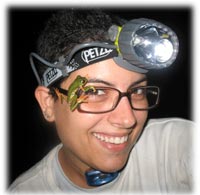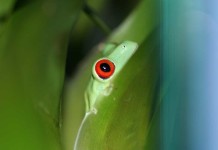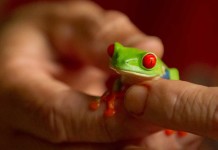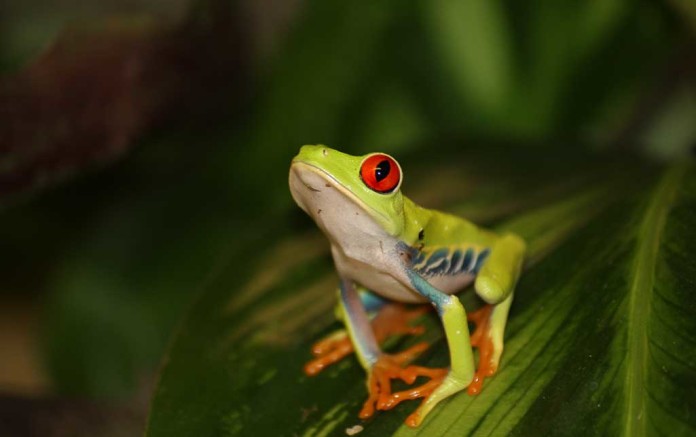Red eyed tree frog research has included studies of the frog’s natural behaviors, its medicinal and material uses. There is much that is still unknown about the red eyed tree frog but research continues into all aspects of this amazing species. What has been found is very revealing and can even save lives.
Adapting for Survival
It has been established that the red eyed tree frog in the embryo state can sense when danger is near from vibrations. A clutch of eggs is very vulnerable to attack by predators, especially snakes. When a snake bites a clutch, the eggs start to hatch, wriggle free and drop to the water below as tadpoles.
Red eyed tree frogs usually hatch within six to eight days, but if attacked they can hatch up to 30 percent earlier. What makes this even more amazing is that other vibrations, such as approaching storms, have no effect on the eggs. It has been established that it is the length of time and the time between vibrations that signal the eggs of danger, causing them to hatch.
Red eyed tree frog researcher from Boston University has conducted and concluded that these frogs continually adapt their response to their environment to sense danger. In that way, the red eyed tree frog embryo maximizes its chance of survival.
A Cure
 The red eyed tree frog has a special chemical in their skin that protects them from infection, bacteria and viruses. This chemical has been found to block the HIV virus that causes AIDS. Unlike many chemicals that have been tried, the one found in the red eyed tree frog’s skin kills HIV particles but leaves the good cells intact.
The red eyed tree frog has a special chemical in their skin that protects them from infection, bacteria and viruses. This chemical has been found to block the HIV virus that causes AIDS. Unlike many chemicals that have been tried, the one found in the red eyed tree frog’s skin kills HIV particles but leaves the good cells intact.
Scientists hope that with further red eyed tree frog research that it will be possible to develop a lotion that protects against HIV and AIDS. Scientists have discovered that the infected cells can be treated up to eight hours after exposure to the virus. The development of this lotion derived from the red eyed tree frog’s skin compound can block the infection.
Sticky Feet
Based on research performed on the red eyed tree frog’s toes, material scientists can apply their findings to developing adhesives for human applications. This would include better tire design, non-slip shoes and even a coating that protects nerves during surgery.
Further research is required to test the adhesion and separation from surfaces on materials much larger than the frog’s toe pads. Just imagine the applications for an adhesive that has the relative strength to larger surface areas.
The research of red eyed tree frog continues for the purpose of discovering more about this remarkable animal. Scientists are already finding applications for humans that can save lives. The red eyed tree frog has proven that it has notable survival instincts from birth. Hopefully this will lead to greater numbers of this frog so that we can continue to learn from them.












